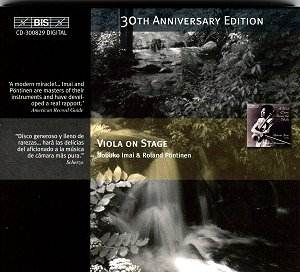This
is one of those rare recital recordings that actually plays best
as a recital. Since each piece seems to lead so perfectly into
the next, I donít recommend jumping ahead to your favourite piece,
or what you think will be your favourite piece. It will sound
best played in sequence with the others. Taken as a whole this
concert comes across as quite a bit more than the sum of its parts.
Ms. Imai gives credit to Mr. Yukihisa Miyayama of King Records
for helping with setting up the program and for once I am ready
to take a bow to both of them for a job well done.
Quite
a number of these works are world premier recordings. The repertoire
for viola and piano is quite small (I think I have all the rest
of it on a single disk by Kim Kashkashian) and the range of styles
of these pieces is from lushly romantic to severely modern, from
furious, violent, drama to the quietest, most fragile meditation,
but each piece was actually published for viola and piano and
nothing has been hastily converted from music for other instruments.
The Britten arrangement of the Bridge piece is a published arrangement,
for instance.
I
think Toru Takemitsu actually achieved what Anton Webern was trying
to get at, that is, music which can be appreciated one single
note at a time with no sense of time flow. I actually enjoy much
of Takemitsuís music whereas Webernís music leaves me bewildered
and uninvolved. But although the album is named after the Takemitsu
piece, it is not the first on the record although I have shown
it as such in the heading for descriptive sake. The Takemitsu
is actually played between the Britten and the Rota, and it fits
perfectly there.
The
Enescu is appropriately theatrical, a good prelude. The Sibelius
is startlingly vigorous and passionate. The two Britten pieces,
especially the unaccompanied elegy, steadily but firmly move us
into an introspective mood so that for the Takemitsu we are ready
to listen with the crystalline attention required. From that the
Rota brings us back with some more symphonic, dramatic, tuneful
music in the form of a theme and variations. With the Milhaud
we go beyond friendly to the almost comical, with echoes of the
best of the Saudades, but coming to a surprisingly dramatic
finish, for Milhaud. All the better because the Persichetti, beginning
with a long cadenza for solo viola, is the quietest, noblest,
most eloquent piece Iíve ever heard from this usually noisy composer;
at moments it could be taken for Debussy! The Wieniawski has a
nice Nineteenth Century operatic lyricism with moments of heart-throbbing
urgency. The Bridge piece (based on a speech where Hamlet reflects
upon the death of Ophelia) begins in an atonal texture, and then
plays with our desire for triads and open intervals by moving
between close-in and far-out mysteryódemanding, as did the Takemitsu,
careful attention and in return giving rich rewards. The Liszt
is a late and very moody, reflective work, bringing the recital
to an elegiac conclusion.
In
the concert hall this would leave us in the mood for some brilliant
and rousing encores, but at home I think we can decide for ourselves
what, if anything, we want to hear next.
Paul
Shoemaker

